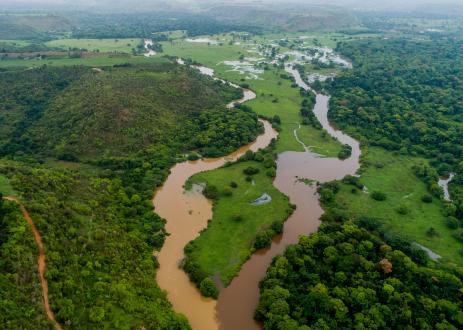全球页岩气开发:水可用性和业务风险

Synopsis
This report analyzes water availability across all potentially commercial shale resources worldwide.
它还表明,除南极以外的每个大陆的水资源开发可能会限制其页岩资源的开发。
Key Findings
页岩资源在全球范围内分布不均匀,在大多数情况下,在淡水丰富的地方都不是。例如,中国,墨西哥和南非拥有一些最大的技术回收的页岩气资源(根据美国能源信息局的估计),但面对页岩所在的高水平压力。
该报告表明,缺乏水可能会削弱世界各地的许多地方的页岩发展:
38%的页岩资源是在干旱或低到极高的水压力的区域中;
19%的季节性变异性领域为19%;和
15 percent are in locations exposed to high or extremely high drought severity.
此外,在这些页岩表演中,有3.86亿人生活在土地上,在30%的页岩戏剧中,灌溉农业是最大的用户。因此,钻孔和液压压裂通常与对淡水的其他需求竞争,这可能会导致与其他用水使用者发生冲突。在高基线水压力的地区尤其如此,在农业,市政或工业目的中,已经撤出了40%以上可用的水供应。
表ES2显示了使用当前可用技术的20个具有最大的页岩气或最紧密的石油资源的国家(ES2)(在此处下载执行摘要).
页岩气资源最大的前20个国家中有八个面临着干旱的条件或页岩资源所在的高基线水应力;其中包括中国,阿尔及利亚,墨西哥,南非,利比亚,巴基斯坦,埃及和印度。
Eight of the top 20 countries with the largest tight oil resources face arid conditions or high to extremely high baseline water stress where the shale resources are located; this includes China, Libya, Mexico, Pakistan, Algeria, Egypt, India, and Mongolia.
水文条件在页岩戏剧中的空间和季节性变化,戏剧,戏剧和全年都有变化。这种差异使公司能够满足液压压裂和钻孔高度不可预测的淡水需求的能力,并且基于以前的经验的估计并不总是准确地准确。这种高水平的不确定性会导致探索新开发领域的公司的业务风险。此外,公众对竞争的增加和对淡水供应的影响的关注可能威胁到公司的社会许可,并导致政府法规的变化可能会影响短期和长期投资。
WRI的调查结果表明,在国际上开发页岩资源的公司可能会面临在世界许多地方进入淡水的严重挑战。这些挑战突出了一个强大的业务案例,用于在当地和地区级别的当地和区域内参与可持续水管理的战略业务案例。他们还指出,公司需要与政府和其他部门合作,以最大程度地减少环境影响和水资源的耗尽。
38 percent世界上的页岩资源面临着很高的水应力或干旱条件。
3.86亿people live on land above shale plays—increased competition for water and public concern over hydraulic fracturing is more likely in densely populated areas.
在中国,61%页岩资源面临高水分或干旱条件。
在阿根廷,72 percentof shale resources face low to medium water stress.
In the United Kingdom,34%of shale plays face high water stress or arid conditions.
Executive Summary
Limited availability of freshwater could become a stumbling block for rapid development of shale resources through hydraulic fracturing. Using information from the Aqueduct Water Risk Atlas, WRI provides the first global and country-specific resource to help stakeholders evaluate freshwater availability across shale plays worldwide.
Innovation in hydraulic fracturing and horizontal drilling techniques is driving the rapid development of shale resources (which include shale gas, natural gas liquids, and tight oil) across the United States and Canada. Already, known shale deposits worldwide have significantly increased the volume of the world’s natural gas and oil resources. Governments from Argentina and the United Kingdom, to Mexico and China, have started to explore the commercial viability of their shale reserves.
The potential for expansion is huge: known shale gas deposits worldwide add 47 percent to the global technically recoverable natural gas resources, and underground stores of tight oil add 11 percent to the world’s technically recoverable oil.
But as countries escalate their shale exploration, limited availability of freshwater could become a stumbling block. Extracting shale resources requires large amounts of water for drilling and hydraulic fracturing. In most cases, these demands are met by freshwater, making companies developing shale significant users and managers of water at local and regional levels, often in competition with farms, households, and other industries.
尽管专家们认为,关键的环境风险和影响与开发页岩相关,但已经证明了表面和地下水的特定风险和影响。和全球页岩气开发:水的可用性和企业风险, the World Resources Institute (WRI) fills this gap, providing the first publicly available, global and country-specific analysis to help evaluate freshwater availability across shale resources worldwide. Using geospatial analysis to combine indicators from WRI’s Aqueduct Water Risk Atlas and other sources with the locations of shale resources globally from West Virginia University and the National Energy Technology Laboratory, the report:
确定大多数需要政府监督和强大的公司政策的地点,以在页岩开发的背景下正确管理淡水供应;和
告知公司与淡水可用性相关的潜在业务风险,并为公司水管理和早期来源水评估提供案例。
除了从全球角度检查水的可用性和页岩资源开发(图ES1)外,该报告还分析了每个页岩播放中首次用水可用性(在页岩形成中可以商业地提取天然气和石油的前瞻性区域),为11国家:阿尔及利亚,阿根廷,澳大利亚,加拿大,中国,墨西哥,波兰,沙特阿拉伯,南非,英国和美国。WRI根据其技术可回收的页岩资源的规模(由美国能源信息管理局估计),当前的探索性和生产活动,未来发展的可能性以及行业,学术界和非政府组织(NOGGO)专家的反馈,选择了这些国家 /地区。。
建议
根据该报告的分析,WRI就政府,企业和民间社会如何在开发页岩资源的情况下如何继续评估和可持续管理淡水可用性提供了一系列实用建议。
1) Conduct water risk assessments to understand local water availability and reduce business risk.
1.1.公司可以评估与水有关的风险。公司应结合全球和资产级工具,公司应确定与水相关的业务风险,并优先考虑与监管机构,社区和行业互动以提高水安全的领域。
1.2.政府可以增加收集和监视供水信息的投资。强大的基线信息以及对未来供水和需求以及环境条件的估计可以帮助建立一个强大的共同知识基础,以告知有效的水政策以及基于科学的目标和目标。
2) Increase transparency and engage with local regulators, communities, and industry to minimize uncertainty.
2.1.Companies can increase corporate water disclosure. By disclosing and communicating their water use and management approach, companies can build trust with financial and river basin stakeholders as they investigate water risks and opportunities. Ongoing disclosure will reduce reputational risks.
2.2。政府和公司可以与地方和地区行业,农业和社区互动。公司应与地方政府,工业,非政府组织和民间社会密切合作,以了解河流域内的水文条件和监管框架。该信息可以更准确地估计访问页岩开发所需的成本,技术和流程,而无需取代其他用户或降低环境。
3)确保足够的水治理以保证水安全并降低监管和声誉风必威官网亚洲体育险。
3.1。公司可以参与公共水政策。足够的水治理和环境保护标准,再必威官网亚洲体育加上可预测的实施和有效的执法,可以最大程度地减少环境退化,并确保公平的水分配和定价。稳定的监管环境使公司和投资者能够评估长期机会并最大程度地降低业务风险。
3.2。Governments and companies, through collective action, can develop source water protection and management plans. Governments and businesses in the early stages of developing shale resources have a unique opportunity to work collectively with key river basin stakeholders to develop source water protection and management plans that help reduce business risks; promote a shared water sourcing and recycling infrastructure; and improve the sustainable management of watersheds and aquifers.
4)最大程度地减少淡水使用并进行企业水管理,以减少对水的影响。
4.1。公司可以最大程度地减少淡水使用。使用公开可用的准则,公司可以评估其使用非污点来源的潜力,并建立用于投资技术以回收或再利用水,使用咸水或以其他方式大大减少淡水撤离的商业案例。
4.2。公司可以制定水战略并参与公司水管理。公司应将水管理嵌入其业务策略的核心,以最大程度地减少风险的接触,并确保其他用户,环境及其运营的长期水利用。企业水管理涉及进步的进步,并在公司内部运营以及其余价值链中的减少进步以及影响减少。

